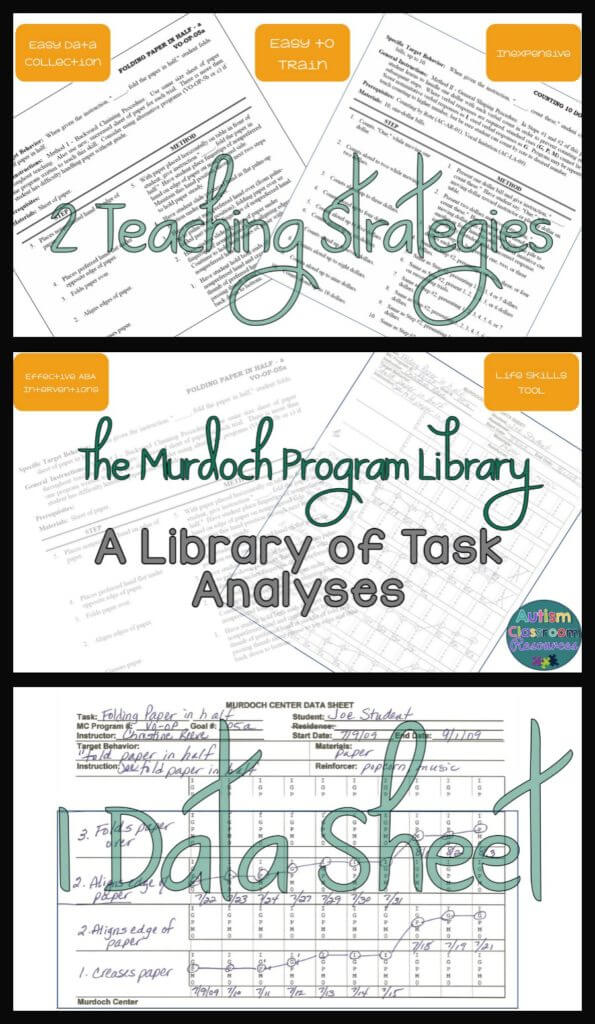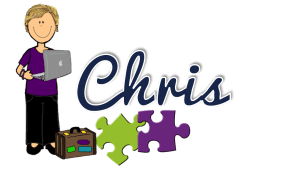I’ve talked about task analyses, backward chaining and shaping in the Effective Interventions in ABA series, so I wanted to share an incredible tool that can help for teaching life skills: The Murdoch Program Library. Because it is sold through an agency and not commercially, you may not have heard of it but I’ve used it in a variety of classrooms and settings from early elementary life skills programs through high school and with adults.
[Tweet “The Murdoch Program Library is an incredible instructional tool for life skills classes.”]

What is the Murdoch Program Library?
Essentially the MPL is a large collection of task analyses for a wide variety of skills from basic academics to vocational skills. It was designed originally for adults with developmental disabilities but is appropriate for any age of learner with moderate to profound disabilities. It’s appropriate for any learner who benefits from consistent, systematic and repeated instruction of basic skills.
It isn’t a curriculum because it’s not a complete scope and sequence–read more about defining curricula here. It was developed by staff from the Murdoch Center and programs were developed as they were needed for the clients. I was lucky enough to work at Murdoch for a couple of years and it is a remarkable center for individuals with developmental disabilities. As part of the habilitation plans for the clients, they developed teaching programs that they could easily train direct care staff to implement. There are almost 1000 programs in the library and it contains some different versions for different skill levels of the clients and a wide variety of skills. The programs use only shaping or backward chaining and there is one standard data sheet to use across all the programs. The data sheet also self-graphs when you collect the data.
Areas Covered by the Murdoch Program Library
- Dressing Skills
- Toilet Training
- Hygiene and Grooming
- Food Preparation, Cooking, Eating, Cleanup, Shopping
- Domestic Skills
- Academic Skills
- Vocational Skills
- Special and Medical Needs
- Leisure, Motor, & Exercise
Advantages of the Murdoch Program Library
- It uses only 2 teaching strategies (backward chaining and shaping), making it easy to train and use consistently across a wide variety of settings. And remember that backward chaining is the teaching strategy that can save you time and make your instruction more efficient.
- It includes the training materials for training staff to use the programs and take data
- It uses 1 data sheet for all the programs (for both teaching strategies), making consistent data collection easier. And the data sheet self-graphs when you complete it, eliminating the need to summarize the data.
- It uses one prompting hierarchy across all the programs so consistency is easy.
- The programs are all formatted the same way so that the staff can easily follow any program in the library once they know how to use them.
- The programs include many skills for students with multiple disabilities including programs for learning switch access, using a wheelchair and other adaptive equipment.
- There are multiple versions of many skills so you can find one to meet the needs of your learner. It’s easy to individualize the steps based on your individual’s needs.
- It trains staff to use both teaching protocols by giving one direction and then using only nonverbal prompts. This increases the likelihood that the student learns the skill and completes it independently without waiting for those extra instructions I talked about in my earlier post.
- It’s very inexpensive for what you get. The complete set of 4 volumes of programs, the manual with the training materials, and a CD-ROM so you can print them all out is only $150.
Tips for Using the Murdoch Program Library to Teach Life Skills
- I highly recommend buying the manuals and the CD-ROM. You can buy just the CD, but only if you have previously bought the manual. Without the manual it’s difficult to find the programs that you need. The programs are coded (for easy editing as the library has grown since 1977), but the codes make it difficult until you get the hang of them to find what you need at times. So having the volumes and the manual handy is helpful. Sometimes it’s easier just to look them up. The CD is helpful though to be able to make adjustments to programs if you need to.
- The programs and data sheets are separate pages and you write the steps into the data sheets as you teach them. Consider posting the steps of the program in the area you teach the skill to serve as a reminder for the staff. I often would copy the program on the back (or staple them back to back) of the data sheet so it was easy to find the steps when it was time to move to the next step.
- Consider posting a sign of the prompts in some of the teaching areas as a reminder to staff since we all know that visual cues are helpful for adults.
- Consider making visual supports like a mini-schedule for some of the skills that use backward chaining–this serves as a reminder to the staff of the order of the steps as much as a reminder to the students.
- Use the library in conjunction with a functional curriculum, like those I talked about this post, that provides a scope and sequence. The Murdoch can provide the teaching strategy and tools but you still need a scope and sequence to tell you what you need to teach.
[Tweet “One of the biggest advantages of using the Murdoch Program Library is that it prevents you from having to recreate the wheel. “]
One of the biggest advantages of using the Murdoch Program Library is that it prevents you from having to recreate the wheel and write your own task analyses. As I said, I have used it with many different types of settings and have found that teachers and staff have really liked having it as a resource. You can check it out, as well as download samples of the data sheet and the programs at the Murdoch website.
Disclosure: I have no affiliation with Murdoch or the program library other than I used to work there many years ago. Nothing was provided to me to write this post–I just really love this tool and wanted you to know about it. 🙂
Have you used the Murdoch or do you think it would be helpful for your program? Share your thoughts in the comments.
I’ll back back this weekend with a post with reading resources. Until next time,





![Summer resources to help survive the end of the year in special education [picture-interactive books with summer themes]](https://autismclassroomresources.com/wp-content/uploads/2018/05/SUMMER-RESOURCES-ROUNDUP-FEATURE-8528-768x768.jpg)

